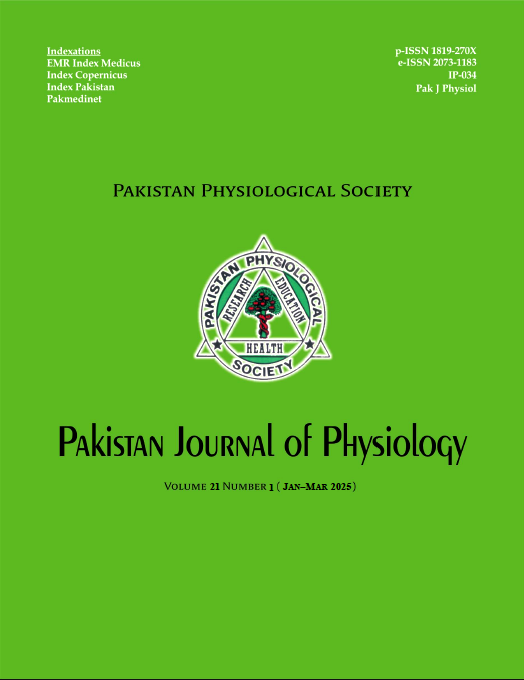TRENDS OF SEDATIVE-HYPNOTICS CONSUMPTION AMONGST THE MEDICAL STUDENT POPULATION OF MULTAN
DOI:
https://doi.org/10.69656/pjp.v21i1.1680Keywords:
Anxiety, benzodiazepine, insomnia, medical studentsAbstract
Background: Medical curriculum has a notoriety of causing work life imbalance and frequent burn outs. To overcome this mental health dilemma the medical students resort to consumption of sedatives. This study aimed to evaluate the tendency of medical students in Multan towards usage of benzodiazepine with emphasis on understanding prevalence rates, drug consumption pattern, and associated socioeconomic factors. Methods: This study was conducted under collaboration of Pharmacology Departments of Nishtar Medical University and Bakhtawar Amin Medical and Dental College, Multan. Data was collected through a modified questionnaire from 400 undergraduate medical students. The sample population was categorized into two groups based on benzodiazepine users and non-users. Data was analysed and interpreted using SPSS-25. Results: On gender comparison female user exhibited a lower odds ratio (OR=1.67, p=0.047). In academic perspective the senior students exhibited varied odds of consumption. Parental with higher literacy level were associated with reduced odds of sedative use (OR=0.48, p=0.035). Individual lifestyle including smoking habits, exercise, and intake of stimulants also displayed significant associations. Students with previous history of drug consumption expressed less intent towards continuation (OR=0.53, p=0.01). Conclusion: The number of female students consuming sedatives was significantly higher than their male counterparts. The progression through academic years significantly correlates with increased sedative consumption particularly peaking in 4th year. Students reporting poor sleep quality were less likely to consume sedatives, a finding that challenges assumptions about the direct relationship between sleep quality and sedative use.
Pak J Physiol 2025;21(5):67?71, DOI: https://doi.org/10.69656/pjp.v21i1.1680
Downloads
References
Chang Y, Xie X, Liu Y, Liu M, Zhang H. Exploring clinical applications and long-term effectiveness of benzodiazepines: An integrated perspective on mechanisms, imaging, and personalized medicine. Biomed Pharmacother 2024;173:116329–40.
Broberg M, Helaakoski V, Kiiskinen T, Paunio T, Jones SE, Mars N, et al. Genetics of sleep medication purchases suggests causality from sleep problems to psychiatric traits. Sleep 2024;47(2): 279–89.
Ishaq N, Ilyas MU, Maria, Malik KA, Rahman Z, Ata N, et al. Self-medication practices in medical students of Nishter Medical University; A cross sectional study. Esculapio: J Services Inst Med Sci 2023;19(3):300–4.
Sarangi A, McMahon T, Gude J. Benzodiazepine misuse: an epidemic within a pandemic. Cureus 2021;13(6):15816.
Dhar R, Dalvi A, Sahu S, Tambekar M, Kotecha B. OSPE as a method of learning and assessment for undergraduate practical pathology versus traditional learning and assessment. J Med Sci Health 2023;9(2):146–51.
McKerrow I, Carney PA, Caretta-Weyer H, Furnari M, Miller Juve A. Trends in medical students’ stress, physical, and emotional health throughout training. Med Educ Online 2020;25(1):1709278.
Mekonnen GB, Debeb SG, Getaw NS, Kifle ZD. Self-reported sedative drug use among students attending at University of Gondar, Gondar, Northwest, Ethiopia: A aross-sectional study. Subst Abuse Rehabil 2021;12:49–57.
Akvardar Y, Demiral Y, Ergor G, Ergor A. Substance use among medical students and physicians in a medical school in Turkey. Soc Psychiatry Psychiatr Epidemiol 2004;39(6):502–6.
Mohammed KA, Abdellaif AO, Abd Eldaiem NA, Ibrahim BA, Elshiekh M. Sedative drug self-medication practice, attitude, and knowledge among medical students at the University of Dongola during 2022. J Appl Health Sci Med 2023;3(7):1–10.
Safaie N, Mirmohammadkhani M, Mashhadi HK. Evaluation of sleep quality of medical interns of Semnan University of Medical Sciences and its relationship with arbitrary use of stimulants or hypnotics. Int J Early Child Spec Educ 2022;14(3):3506–14.
Al-Sayed AA, Al-Rashoudi AH, Al-Eisa AA, Addar AM, Al-Hargan AH, Al-Jerian AA, et al. Sedative drug use among King Saud University medical students: a cross-sectional sampling study. Depress Res Treat 2014;2014:378738.
Fond G, Bourbon A, Boucekine M, Messiaen M, Barrow V, Auquier P, et al. First-year French medical students consume antidepressants and anxiolytics while second-years consume non-medical drugs. J Affect Disord 2020;265:71–6.
Zavarmousavi MS, Isanazar A, Ezbarami ZT, Mossalat M, Massoodi A, Novin MH. Frequency of the benzodiazepines and serotonin-specific reuptake inhibitors use in medical students: a mixed method study. Clin Cancer Investig J 2021;8(S1):220370.
Ilic I, Zivanovic Macuzic I, Kocic S, Ilic M. High risk of burnout in medical students in Serbia, by gender: A cross-sectional study. PLoS One 2021;16(8):e0256446.
Pérez T, Pardo MC, Cabellos Y, Peressini M, Ureña-Vacas I, Serrano DR, González-Burgos E. Mental health and drug use in college students: Should we take action? J Affect Disord 2023;338:32–40.
Sapkota A, Silvanus V, Shah P, Gautam SC, Chhetri A. Psychoactive substance use among second-year and third-year medical students of a medical college: A descriptive cross-sectional study. J Nepal Med Assoc 2021;59(238):571–6.
de Mendonça FMR, de Mendonça GPRR, Souza LC, Galvao LP, Paiva HS, de Azevedo Marques Périco C, et al. Benzodiazepines and sleep architecture: a systematic review. CNS Neurol Disord Drug Targets 2023;22(2):172–9.
Downloads
Published
How to Cite
Issue
Section
License
Copyright (c) 2025 Noaman Ishaq, Nausheen Ata, Hamnah Fatima, Mahwish Gul, Saba Batool, Maryam Saqib

This work is licensed under a Creative Commons Attribution-NoDerivatives 4.0 International License.
The author(s) retain the copyrights and allow their publication in Pakistan Journal of Physiology, Pak J Physiol, PJP to be FREE for research and academic purposes. It can be downloaded and stored, printed, presented, projected, cited and quoted with full reference of, and acknowledgement to the author(s) and the PJP. The contents are published with an international CC-BY-ND-4.0 License.











